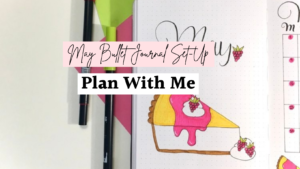Staying motivated might be one of the hardest things to do when it comes to bullet journaling! So much effort goes into it! You have to research your spreads, come up with new themes every month, create the spreads, and everything else. Once you’ve created your bullet journal, you have to make sure you use it too.
All that effort and you still need to keep it up! It can feel impossible most days to get all of that done, which leads to missed days where you don’t add anything to your journal. Or you just forget. Those missed days can be such an obstacle. Staying motivated is key to bullet journaling! Working daily on your bullet journal can help you to see all the benefits you get from bullet journaling.
The key to staying motivated while bullet journaling is psychology, or more specifically, operant conditioning! You need to reward yourself for bullet journaling to encourage the behaviour!
Why You Need to Bullet Journal Daily
Sadly, bullet journaling isn’t something you can pick up any day of the week or month. For it to be truly effective, you need to bullet journal daily.
A lot of spreads used for bullet journaling are meant to be used daily. Habit trackers, water trackers, weekly spreads, etc. As easy as it would be to only bullet journal every few days, it won’t have the benefits you are looking for. (You can see some of the benefits here!)
When it comes to tracking, you’re out of luck if you don’t track that habit every day. If you want to get better at doing an activity every day, tracking it weekly isn’t going to help you. It’s as simple as that! You won’t remember if you did that habit every day if you don’t track it daily.
The same goes for mood trackers. I can hardly remember what my moods were over the day let alone all the emotions I felt that week!
You’ll get the most out of bullet journaling if you do it daily! The hard part is sticking to it!
Operant Conditioning
Operant conditioning might be a new term for some of you, so let me explain it a little. This type of conditioning is a system for improving or removing a certain behaviour using rewards and consequences. That probably sounds confusing. Let’s try again!
When you reward a behaviour, you encourage it. And when you punish a behaviour, you discourage that behaviour. Basically, behaviours can be encouraged or discouraged based on the consequences of those behaviours.
You have to pay attention to how you treat your bullet journal because you might be encouraging it or discouraging it without knowing!
When it comes to encouraging a behaviour, there are two ways to do that: positive reinforcement and negative reinforcement.
Postitive Reinforcement
Positive reinforcement is easy enough to understand and you are far more likely to use it compared to negative reinforcement in this case.
Positive reinforcement is getting something to encourage a behaviour.
When it comes to positives and negatives in operant conditioning, they simply mean adding something or taking something away.
If you want to positively reinforce a behaviour, you have to give that person something they want. It won’t work if they don’t like it. For example, to reinforce cleaning the house, a parent might give their child a sweet every time they clean their room.
When it comes to bullet journaling, you can easily encourage yourself using this practice! You simply need to track how often you use your bullet journal. (Just add bullet journaling to your habit tracker and mark every day you used your journal.) If you journaled every day for a week or a month, reward yourself!
It might seem kind of complicated but all you need to know is that to encourage bullet journaling, you have to give yourself something you want in exchange for working on it.
Negative Reinforcement
Negative reinforcement is, of course, the opposite, but it is where people get confused. You don’t give people negative things to reinforce behaviour but you can take negative things away.
The negative, in this case, refers to taking something away that you won’t like. It’s unlikely that you will be using this kind of reinforcement. It’s a little harder to do when reinforcing bullet journaling.
But here’s an example! Let’s say a child doesn’t want to clean their room (I don’t know why I keep using this example. Sorry!) and their parent keeps nagging them. Eventually, the child will clean their room and the nagging will go away. By taking away the thing they didn’t like (the nagging), the parent encouraged that behaviour.
Now, I don’t suggest you go nagging your kids to clean their rooms. They would actually have to clean their rooms and you would have to stop nagging altogether. It’s not the easiest thing to do! Negative reinforcement is hard to put into practice.
All I’m trying to say is that you remove something undesirable after they do the behaviour you want.
As a word of caution, I wouldn’t suggest using negative reinforcement unless you do more research because you could accidentally punish your behaviour instead of encouraging it. For instance, you decide to make a loud noise play in the background that you get to turn off when you finish bullet journaling. It might seem like you are taking something away that you don’t like, but in reality, you added something you didn’t like instead of taking it away.
Possible Rewards
Now that you know how reinforcement works, let’s get into what you need to make it happen!
For positive reinforcement, you need to add something that will motivate you. For example, when I was in school and needed to study, I told myself I could have a smoothie if I studied for a few hours every day and got all my work done. It was a gruelling few weeks but at the end of each week, I was allowed to have my smoothies. It was worth it!
The only reason that it worked was that I wanted that smoothie! But I also didn’t give myself the smoothie if I didn’t study as much as I needed to.
You have to remember that you can’t give in to your desires or they won’t reinforce your behaviour. It won’t matter if you get that smoothie at the end of the week if you already had one a few days ago!
You have to give yourself something that you both want and that you can withhold. People’s electronics and food are typically pretty good examples of reinforcers. You can buy yourself a cookie at the end of the week if you journal every day of the week. You could try allowing yourself 30 minutes on social media if you created 2-3 spreads and layouts in your journal.
It doesn’t matter what you do as long as it reinforces bullet journaling and habit tracking!
In All…
I know this can be a little confusing so let’s stick with: give yourself something you like and take away what you don’t like if you do your bullet journaling daily! It doesn’t have to be complicated. The point is simply that you have to motivate yourself to bullet journal. A lot of effort goes into bullet journaling so you have to find a way to make it worth it for you! Get as many benefits you want out of bullet journaling as you can! If you have any questions, please feel free to let me know in the comments. I would be glad to help!
Related Articles
- Simple Ways to Stop Bullet Journaling from Causing You Stress
- Bullet Journaling Mistakes and How to Fix Them











